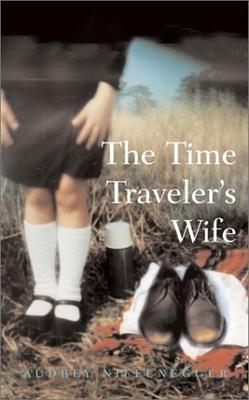written by David Steffen

The Time Traveler’s Wife is a 2003 time travel romance book written by Audrey Neffenegger, about a man afflicted with a condition that causes him to time-travel more-or-less randomly and the woman he marries. The book was very popular and inspired a 2009 movie adaptation of the same name, previously reviewed here.
Henry has experienced the time-traveling condition since he was a child. When he travels, only his body is transported, so he does not take along his clothes, wallet, or any other possessions. He learned from a very early age to be ruthlessly pragmatic as a way to survive, because if you get dumped with no clothes and no resources into random locations you’re always against steep odds of getting arrested or starving or whatever else. He has a more or less central timeline that is the trunk from which all of his time travel branches, so he has some normal continuity, but at seemingly random intervals he will travel for seemingly random amounts of time to seemingly random places.
He spends much of his life just trying to survive and get by, until he runs into Clare in his main timeline (when he is in his 30s and she in her 20s) and she tells him that she’s known him since she was a grade schooler and that they’re going to get married in the future. He hasn’t experienced this yet, but early in her life he gave her a list of the times when he would appear in the grove outside her family’s house so that she could remember to bring food and clothes out to him.
Their romance after that is very complicated, as at any given point they are in different parts of their relationship, just as with this initial meeting where she has known him for most of her life and he’s just met her. He then proceeds to meet her as a child and eventually meet her when it was the first time for her. It’s a story of marriage, the obstacles to finding happiness together and what we do to fight for it, and in many ways is about being in different parts of a relationship at the same time, which I think can be true of real relationships that have no time travel involved.
As with the best speculative stories, this one explores real territory with a speculative lens for emphasis. The characters are very different but compelling (with a plus that I didn’t have to watch Eric Bana’s acting for the book, but the minus that I didn’t get to watch Rachel McAdams’s acting). I thought the book as a whole was reasonably well done.
One of the big hangups I had about the book, not being able to tell where in the timeline this fit in, was resolved in the book by section headings that gave the date and the age of both characters. Time is always somewhat confusing at the best of times, but this made it a lot easier to just go with it than I found the book to be.
I also thought it was interesting how Neffenegger chose to follow the continuity thematically rather than necessarily chronologically for either character in particular. For a series of chapters it may follow Clare chronologically through a particular set of years to explore themes of her childhood, then follow him chronologically from his point of a view for a while to show how he ended up there, then switch to something else. Because of the caption headings this was reasonably seamless and I probably only really thought about it because I was thinking about the writing process.
The big thing that makes the book harder to recommend is that for much of the first quarter or so of the book, 30-something Henry is interacting with grade-schooler Clare and I found that whole section of the book deeply creepy and troubling. By that time, he already knows that he will marry her someday when she’s older, and he depends on her for food and clothing on these visits where he would otherwise have to steal and forage like his other time travel jumps. So, it makes sense from a character motivation perspective. But at the same time, it’s hard to avoid the interpretation that he is grooming her during this period. If you removed the time travel element and you had a thirty-something man hanging around a grade-schooler without her parent’s knowledge while mentally preparing himself to marry her, that would be a story about a predator. There are reasons to think that’s not where this was going, but I found it really hard to shake myself off of that interpretation, so throughout this whole section I really just wanted it to be over and get to the part where they’re both consenting adults (even thought that was also somewhat colored by her having been groomed by him for so long that she’s bound to have feelings for him). I’m not sure that was supposed to be creepy or disturbing, but for me it absolutely was, and it makes the book hard to recommend as a result, though overall I thought it was pretty good.

yes, really really creepy and disturbing…no ifs about it. The whole movie…especially now in 2021 when we actually pretend to know something about the subject of grooming and child brides being prepared for marriage…. yuck all the way through. Nothing cures it.